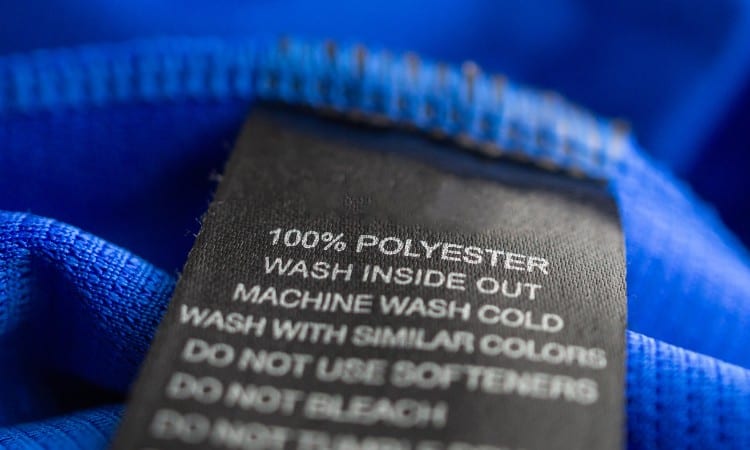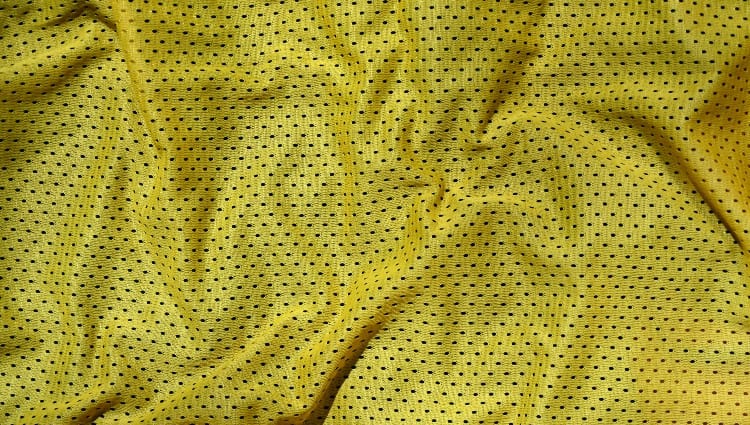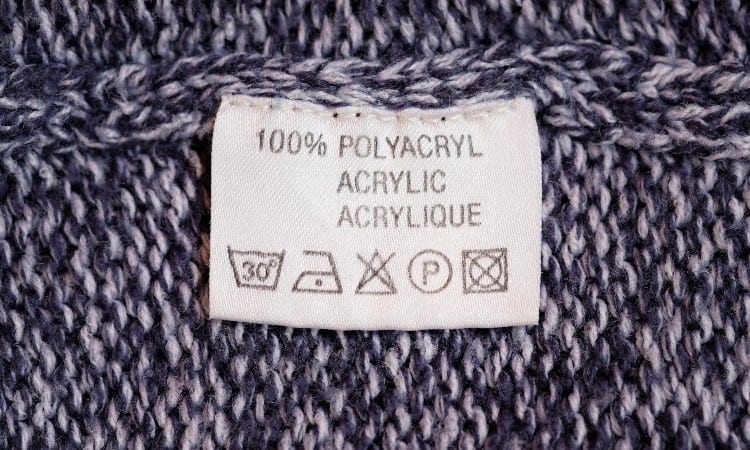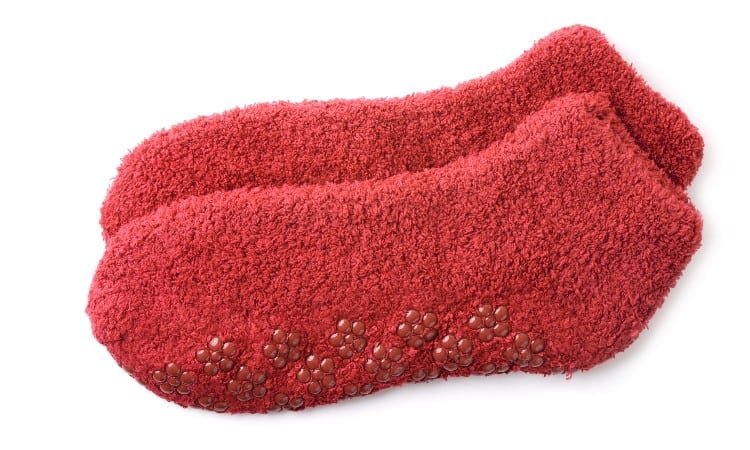Would you believe that your coziest, most comfortable sweater is very likely made out of plastic? You probably want to know more about the synthetic fabrics that form a huge part of the clothing industry. For example, if you look at polyester vs acrylic, what are the differences between these popular fabrics?
The main difference between polyester and acrylic is that polyester is more breathable and acrylic is a better insulator. Both fabrics are synthetics manufactured out of petroleum. Polyester is a versatile material popular in many types of garments, while acrylic is used for warm-weather clothing.
In this article, you’ll find out the characteristics of polyester and acrylic. You’ll also get a good look at the main differences between these materials. Finally, you’ll get to consider the pros and cons of each type of fabric in certain situations like warm and cold weather.

Polyester Vs Acrylic: Key Points
At first glance, polyester and acrylic seem quite similar. Factories make both fabrics essentially the same way. On top of that, both synthetic materials contain chemicals that come from petroleum.
But the materials have different molecular structures. This gives them several unique features.
Here’s a quick overview of the key characteristics of these synthetic materials.
Warmth: Acrylic is warmer, though polyester is also a good insulator
Water Resistance: Both materials have high hydrophobic qualities. Polyester resists water absorption slightly better.
Breathability: Depending on its structure, polyester has excellent breathability, while acrylic lacks breathability.
Durability: Both materials have strong, long-lasting fibers. That said, polyester is more durable.
Cost: This depends on the kind of item and type of material. In general, both synthetic fabrics are an affordable alternative to natural materials.
What is Polyester Fabric?

In simple terms, polyester is plastic melted into yarns that factories weave into cloth. This fabric has many great qualities, like its affordability and durability. People also love its advanced performance capabilities like moisture-wicking and weather-resistance.
If you want to understand what makes this synthetic material unique, though, you’ll have to look at its composition a bit more closely.
The first step in the making polyester involves two organic compounds reacting together under the catalyst of high heat. (If you want to know, these compounds are dimethyl terephthalate and ethylene glycol).
This creates a type of alcohol molecule called a monomer. When this alcohol combines with an acid in a process called polymerization, clear, melted polymer emerges!
From here on out, manufacturers can decide how to process the material. For example, some polyester yarns get crimped and folded into accordion-like shapes while the plastic is still hot. This gives the yarn unique stretching abilities.
All polyester has strong, straight, repeating monomers comprising its fibers. This is what makes the fabric tough and water-resistant. At the most basic level, polyester fibers are tiny little bits of plastic.
One of the reasons polyester is so popular today is its extreme versatility. This fabric can be made into many, many different kinds of cloth.
This was not always the case. During WWII, scientists invented several synthetic fabrics to aid the war effort. Polyester’s first appearance in the States happened during this time, but it took a while to gain traction.
In the past couple of decades, textile arts advanced enough to reinvent the way polyester was used. Today, this material shows up in everything from athletic wear to formal wear. In fact, it is so cheap to produce and so popular that it makes up as much as sixty percent of the retail clothing market!
Some people dislike polyester because it can have a clingy, plasticky feel. But other types of polyester have excellent moisture-wicking and breathability! How is this possible?
Think of polyester fibers like basic, four-hole Lego bricks. The bricks all look the same, but you can build them into thousands of different designs–castles or pirate ships or aliens from Mars! Factories can turn polyester fibers into thousands of different types of material, just like the Legos.
It all depends on how the factory weaves, knits, or structures the fabric.
What is Acrylic Fabric?

Acrylic fabric is a synthetic material made out of a polymer called acrylonitrile. This cloth almost entirely lacks breathability, which makes it an excellent insulator. Acrylic makes great coats, jackets, and linings because it holds in heat so well.
In practical terms, acrylic has replaced wool in much of the clothing industry. Its fibers have a soft texture that pretty closely imitates the natural material.
Are you wearing a sweater right now? Maybe a cozy cardigan or a baggy sweater-dress? Check the manufacturer’s label inside if you can reach it easily.
Chances are pretty good that your sweater is made out of 100% acrylic! A huge percentage of all the sweaters sold today contain this material. It costs much less to make acrylic than it does to farm sheep and process the wool.
The acrylic cloth also begins as organic compounds with fancy names. These Compounds undergo the polymerization process to get turned into plastic.
Polymerization is a fancy term for a process that creates a repetitive molecular chain. As you might expect, this means that acrylic has a strong, stable molecular structure.
Acrylic also gets processed in factories with giant spinnerets. These machines extrude the melted plastic through their fancy nozzles. This creates acrylic fibers.
Manufacturers can choose several processes to turn these fibers into acrylic yarns. This depends on what type of acrylic material they plan to make. For example, carpeting versus a coat lining.
Is acrylic good material for clothes? Well, yes and no.
Some people have concerns about the health and environmental issues surrounding synthetic fabrics. Others have more practical concerns: acrylic has no breathability. This means it is only comfortable in cold climates.
That said, if you live somewhere with a chilly winter season, you may well appreciate an insulating acrylic liner inside your winter coat. And many of you probably enjoy the warmth of an acrylic sweater while you watch the leaves change color in the fall!
What’s the Difference Between Polyester and Acrylic?
Polyester fabric is breathable and acrylic material is not. Another key difference is that polyester is a versatile material with many uses. Acrylic is so impermeable that it can only serve as an insulating material in warm-weather clothing.
Acrylic can also have a much softer texture. This depends on how manufacturers process the synthetic fibers. In general, acrylic replaces wool in the clothing industry, and polyester replaces cotton.
The main difference between acrylic and polyester yarn is texture. The acrylic yarn has a soft, fuzzy feel, almost like cashmere because of the way it’s manufactured.
Let’s take a closer look at each material’s key characteristics to give you a clear idea of what each fabric is like.
Warmth

Which is warmer, polyester or acrylic? This is kind of a trick question. Acrylic serves almost exclusively as an insulating material, and some people consider it even warmer than wool!
That said, its lack of breathability can make it almost oppressively hot. Because of this, polyester makes better fill material inside a coat. Both materials have excellent weather resistance, which can help keep you warm outside.
The tightness or looseness of the weave also plays a role in the warmth of any fabric. If polyester has a very tight weave, it becomes less breathable and much warmer.
Ultimately, though, acrylic is the warmer of the two fabrics. Both materials see frequent use as boot linings, glove linings, coats, hats, jackets or jacket linings, and cozy sweaters.
Water Resistance
Polyester and acrylic are naturally hydrophobic, meaning that their fibers do not absorb water. This makes total sense when you realize that the fibers are plastic.
As fabrics, though, these materials are not totally waterproof: water can pass through any gaps between the threads.
This is a good thing. Textile manufacturers take advantage of this characteristic when they create moisture-wicking cloth.
Moisture-wicking fabrics balance the wetness on either side of the material. If you are sweating, the sweat slides through the fabric to evaporate into the air!
Some popular winter wear and sportswear clothing blend polyester and cotton. This merges the comfort of natural fibers with the moisture-wicking of synthetic fibers. Acrylic and wool form another popular blend.
Breathability
As you now know, polyester tends to be more breathable than acrylic. Of course, this depends on the structure of any individual material. Acrylic, though, almost always lacks any ventilation.
Why does breathability matter? Well, if you’re camping in ten-degree weather, you probably want socks and long underwear that are not breathable. This way none of your body heat can escape!
On the other hand, if you’re jogging outside on a warm spring day, you want air to flow through the fabric of your clothing to keep you from overheating.
Natural materials such as cotton have porous fibers that absorb water and allow air to flow through them. Synthetic fibers do not.
Synthetic fabrics require special weaving to build air gaps that allow for good ventilation. The yarns’ shape also makes a difference in how much air can pass through a synthetic cloth.
All of this goes to say that polyester is usually more breathable than acrylic. However, this depends on the construction of the fabric.
Durability
Polyester is generally considered tougher and longer-lasting than acrylic. The molecules in polyester attach strongly and don’t like to pull apart. But in terms of decomposition, acrylic holds out far longer.
Both synthetic fabrics make strong showings in tough outdoor uses, such as patio upholstery and awnings. These materials last a long time and hold up well under elements such as wind, water, and sunlight.
Lots of hiking, camping, and sportswear contain polyester, largely because this fabric is so durable!
Recyclable
Some types of polyester fabric can be recycled. However, acrylic is not recyclable. Experiments have shown that acrylic takes more than one hundred years to biodegrade!
The acrylic fabric is no longer manufactured in the United States. This change occurred partially because of environmental concerns. (It is, however, still widely sold in the States, so make of that what you will!).
Some forward-looking companies produce polyester from discarded plastic items like soda bottles. This offsets the biggest argument against synthetic fabrics, which is the cost of pollution.
Synthetic fabrics, in general, do add considerably to the issue of plastic pollution around the world. Of course, for many consumers, the affordability of these materials makes up for the danger of pollution.
Comfort
Circumstances determine whether polyester or acrylic is more comfortable to wear. Acrylic can be very soft to the touch, leading some people to consider it more comfortable. On the other hand, polyester is more breathable, making it the more comfortable fabric in warm weather.
Both fabrics can have issues with static cling, a common problem among synthetics. Acrylic fabric also tends to pill a lot. This can make it look worn-out even if it isn’t that old!
It is worth noting that both materials are also oleophilic. This means they can hold onto oil-based odors such as body odor even after washing.
Most people would probably consider polyester the winner in a comfort contest. It is so versatile that it can provide comfort in many different circumstances.
Common Uses

Polyester is used in almost everything you can imagine. Acrylic fabric primarily features in warm-weather clothing and outdoor furniture like patio upholstery.
More than half of all the clothing sold around the world contains a significant portion of polyester. Some favorites include items like winter coats, leggings, athletic wear, and t-shirts. A lot of formal attire such as dresses and skirts also contain polyester.
Polyester is also a popular choice for household items such as curtains, bedding, upholstery, and even carpets!
Acrylic fabric, on the other hand, has a much smaller footprint. It stars in warm-weather wear such as coat linings, gloves, scarves, and sweaters.
Craft stores also sell a wide range of acrylic yarns for the home knitter since these cost a lot less than natural yarn like wool.
Cost
It’s difficult to determine if it costs less to produce polyester or acrylic. Both types of synthetic material cost a lot less to manufacture than any natural fabric. Both materials require roughly the same factory manufacturing process.
In terms of a specific item, the cost depends on the style and brand of the item itself more than the material it is made of. You may find an acrylic sweater for sale from one retailer for ten dollars less than a polyester sweater sold by another retailer. However, this is more about style and branding than the cost of the material.
Remember, synthetic fabrics were originally designed as cheaper alternatives for natural fabrics. This is why they are so prevalent today!
Pros and Cons of Polyester
For most people, polyester’s greatest advantage is its low cost. Its greatest disadvantage is its environmental impact.
Some people also wonder if polyester is bad for your skin. Most studies seem to indicate that this is not the case. Some people do have an allergic reaction to the chemicals sometimes used to treat the fabric.
Depending on the method used to weave the material, you may find polyester hot and sticky. This could irritate your skin.
That said, better types of this material have breathability and moisture-wicking qualities. These qualities will prevent such irritations!
Let’s take a quick look at some of the pros and cons of this popular material.
Polyester is:
- Extremely affordable and often replaces cotton and silk in the clothing industry
- Washable and easy to care for
- Durable and does not wrinkle, pill, or mold easily
- Sun, wind, and water-resistant, making it an excellent choice for outdoor wear
- Considered harmful to the environment
- Oleophilic, meaning that it can hold onto bad odors
Pros and Cons of Acrylic
Acrylic makes excellent warm clothing, and its softness allows it to replace wool in much of the retail clothing industry today. However, many consumers worry about the pollution that goes along with using synthetic fabrics. Some consumers also mention that acrylic can prove itchy in warm weather and works better in cold climates.
Here’s a quick look at some of the pros and cons of this popular material.
Acrylic is:
- Incredibly warm, and often serves as a replacement for morse costly natural wool fibers
- An affordable choice for many consumers
- Oleophilic, meaning that it can hold onto bad odors
- Moisture-wicking, making it a good choice for athletic wear in some circumstances
- Not breathable and a bad choice for warm temperatures
- Not recyclable, leading to concerns about pollution
- Sun, wind, and water-resistant, making it popular for outdoor use
Popular Products Made of Polyester and Acrylic
Despite the pros and cons of each material, polyester and acrylic remain two of the most popular fabrics for many, many different uses!
In general, you’ll see polyester available more often than acrylic. Sometimes, though, you may need to choose between these materials.
So, let’s get down to the nitty-gritty! If you want a blanket, patio furniture, or socks, which material should you buy?
In the battle of polyester vs acrylic blankets, polyester scores highly for prevalence. Acrylic scores for softness.
Have you ever owned one of those uber-soft, fake-fur mink blankets? Believe it or not, these are made out of acrylic! On the other hand, polar fleece blankets are made out of polyester. Both types of blankets have many fans, and both provide lots of softness and warmth.
You have probably compared polyester vs acrylic outdoor fabric if you plan to purchase items for your backyard. For example, a lot of patio furniture, beach umbrellas, and awnings contain these materials.
In all honesty, this one is probably a tie. Both fabrics have the durability and weather resistance necessary to stay nice outside.
Some retailers sell the best of both worlds by creating something called acrylic-coated polyester. This material features woven polyester dipped into a colored acrylic coating.
What about a more prosaic item, like socks? Some people recommend acrylic socks for activities such as hiking. They provide lots of insulation to keep your feet warm!
On the other hand, no one wants hot feet, so acrylic socks shouldn’t be worn in warm weather. Polyester socks make better all-around footwear.
Let’s look briefly at a couple of real-life examples!
BALEAF Women’s Long Sleeve Shirts
 This long-sleeved 100% polyester shirt makes great outdoor apparel. The lightweight material will keep you cool while you move with its breathable and moisture-wicking fabric.
This long-sleeved 100% polyester shirt makes great outdoor apparel. The lightweight material will keep you cool while you move with its breathable and moisture-wicking fabric.
It will also provide a great base layer for insulation if you plan on winter hiking or camping!
This shirt comes in over thirty different colors and has raglan sleeves for extra mobility. It is machine washable and will last a long time without wrinkling or fading! Washing will not impact the shirt’s greatest quality, which is its SPF sun protection!
GRECERELLE Women’s Pullover Sweater
 This lovely, asymmetrical sweater celebrates the softness of the acrylic yarn. It features a stylish boatneck and chunky buttons.
This lovely, asymmetrical sweater celebrates the softness of the acrylic yarn. It features a stylish boatneck and chunky buttons.
The pullover sweater also has a crossover wrap, thick knit, and turtle neck cowl.
It comes in seventeen different colors to match your favorite fall outfit!
The sweater does need careful handwashing in cool water and air drying away from direct sunlight. But its comfort, charm, and affordability make up for the extra work!
Conclusion
Polyester and acrylic are both affordable synthetic fabrics. They both provide excellent durability and water-resistance. Acrylic fabric offers great insulation and polyester provides more breathability.
Acrylic fabrics usually feature in cold-weather clothes like sweaters and gloves. Polyester’s versatility makes it an excellent choice for many kinds of clothing and household items.
Next time you go shopping, look at the manufacturer’s labels inside the clothes. You may spot quite a few items made from these synthetic fabrics! Leave a comment below to let us know what you think of these popular materials!